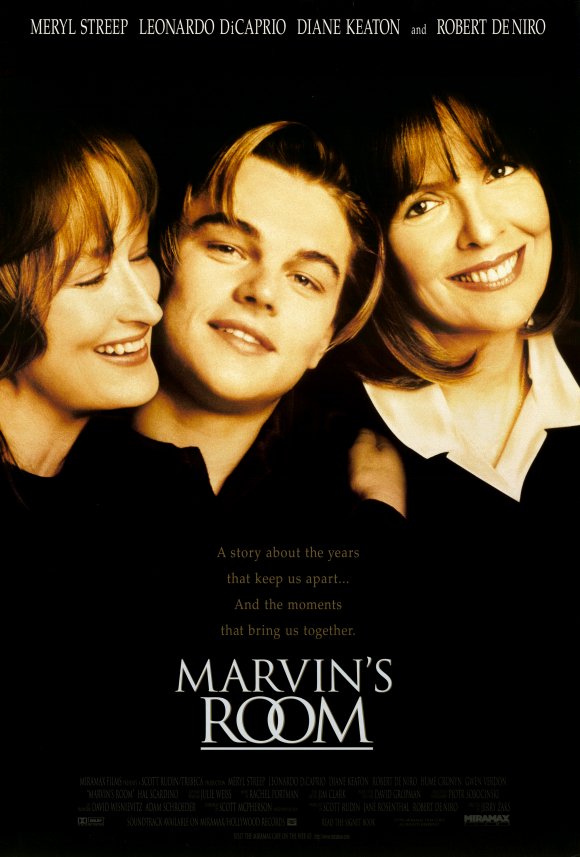 If you want to see how disdain blends into love, sorrow blends into laughter, airiness blends into gravity and an “A†class cast blends into down-to-earth people with all their hopes and sorrows, then “Marvin’s Room†is a movie to see.
If you want to see how disdain blends into love, sorrow blends into laughter, airiness blends into gravity and an “A†class cast blends into down-to-earth people with all their hopes and sorrows, then “Marvin’s Room†is a movie to see.
Despite its low-budget, lack of fancy effects, and relatively low score at the box office, this dramatic comedy will leave its footprints in your mind and heart, making you ponder the very definition of love, family, and fragility of human life.
The Tony Award-winning German director Jerry Zaks, most famous for his Broadway flicks, proves once again that he is able to further revive and replenish theatrical pieces; indeed, his film “Marvin’s Room†is a big-screen adaptation of playwright Scott McPherson’s 1991 play bearing the same time. Of course, Zaks fuels the simple dramatic plot with more vivid dialogue, verisimilitude scenes, and stellar actors such as Leonardo DiCaprio, Meryl Streep, Diane Keaton, and Robert DeNiro. Despite their high level of stardom and publicity, those actors make their on-screen characters as believable as ever and keep the thespian action going.
“Marvin’s Room†tells the story of two estranged sisters Lee and Bessie who are brought closer, both geographically and emotionally, by unpleasant news. Lee (Streep), a frivolous single mom from Ohio and an aspiring cosmetologist, is constantly being victimized by life: her husband has left her, all her boyfriends prove to be good for nothing, there is hardly any money in the house to provide for her two sons and is left homeless when her sensitively disturbed older son Hank (DiCaprio) is confined to a mental institution after burning down the house.
Bessie (Keaton) doesn’t have a picnic-like life, either. Despite the fact that she resides in a beautiful house down in sunny Florida, she has to take around-the clock care, without Lee’s help of course, of her senile ailing parents. Yes, the problems-ridden sisters live in a total isolation from one another until the otherwise merry and fun-loving Dr. Wally (DeNiro) gives, in-between joking and laughing, Keaton’s character the news- leukemia. Since the sole way for Bessie to survive is to have a bone marrow transplant, she reluctantly reaches out to her sister and nephew, the sister and nephew she hasn’t sent a single Christmas card for seventeen years.
This awkwardly delicate situation turns out to be a test and revelation for a lot of underlying motifs, besides the unavoidable need for a donor: son-mother love, parental attachment, fraternal closeness, secrets from the past, sanity, etc. We learn that the seemingly despicable actions of DiCaprio’s character are triggered by something much deeper than spite and rebelliousness; Hank is searching for the paternal figure his mother never let him have. The fancy state-of-the art nursing home seems the perfect solution for Bessie regarding her parents’future but Bessie’s moral obligation to them is stronger than the simple convenience.
The scenes where Streep and Keaton are trying their best to cover the underlying sense of detachment by conversing about trivial things such as hairstyles and chips are the perfect indicator of the complicated feelings the two sisters harbor toward one another. Yet, Lee and Bessie break the ice of their strained relationship when Keaton’s character shares a secret about her lost love with Streep’s. Ruth, Lee and Bessie’s mother, seems to be the happiest person in the whole family. She can’t wait to see the finale of her favorite soap opera where the major character Coral is finally getting married. Of course, Ruth is senile and can’t really comprehend what is going on.
However, her excitement over such illusionary matter serves as a message that life has to be enjoyed to the fullest and that happiness could be found even in the most insignificant things. This is what Lee, Bessie, and Hank should learn in order to move on.
All the abovementioned characters and scenes couldn’t have been brought to life without the excellent dramatic skills of the actors. DiCaprio’s boyish looks, naïve mien, and carefree manners fill up the sketch of its character Hank to the brim. Despite the fact that, in “Marvin’s Room,†he is still far away from his “Titanic†heartthrob image, Hank wouldn’t be illustrated to the fullest without DiCaprio’s charisma of innocence. Given the fact that Meryl Streep’s most typical roles are those of single mother-courages dealing with the life entanglements (“Kramer vs. Kramer,†“Mother Courage,†“It’s Complicatedâ€), she is about the perfect person to portray Lee.
Diane Keaton (“The Godfather,†“Annie Hallâ€), on the other hand, casts a slight shadow over Streep in her (Keaton’s) masterful control of the emotional dialogues between the sisters. And,…last but not least, Robert DeNiro betrays (successfully) his usual image of a snobbish New Yorker when giving the movie, through his character Dr. Wally, a subtle funny edge.
The TV stars Cynthia Nixon (“Sex and the Cityâ€) and Kelly Ripa (“All My Childrenâ€) also make excellent cameo appearances as, respectfully, the professionally polite nursing home manager and Ruth’s favorite soap opera Coral.
Despite the fact that “Marvin’s Room†doesn’t exactly have the typical Hollywood-like happy ending, it still leaves the viewers with a sensation of inner fulfillment.

Leave a Reply